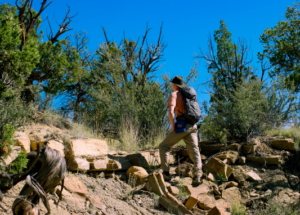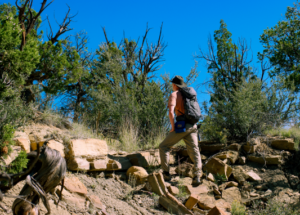
Author: Thomas Valenzuela
Master’s Thesis Defense, New Mexico State University
Date: May 2025
Thomas’s Master’s Thesis
Date: May 2025
Read Thomas Valenzuela’s Master’s Thesis
Abstract: Sedimentologic, stratigraphic, and provenance data from siliciclastic nonmarine strata of the lower(?) Eocene San Jose Formation provide new insights on the depositional style, stratigraphic relationships, and sandstone modal composition trends across four key members of the San Jose Formation that crop out in the southeastern part of the San Juan Basin in northwestern New Mexico. Presented here are new sedimentological and stratigraphic data (e.g., measured stratigraphic sections and facies analysis) as well as provenance data (e.g., U-Pb detrital zircon geochronology, sandstone modal composition, and clast counts) from the Cuba Mesa, Regina, Llaves, and Tapicitos Members of the San Jose Formation. New measured sections record near-continuous sedimentation during deposition of the basal Cuba Mesa Member and overlying Regina Member as well as across the younger Llaves and overlying Tapicitos Members. The Cuba Mesa Member marks the base of the San Jose Formation and
viii shares similar sedimentologic characteristics with the overlying Regina Member. Both members consist largely of laterally extensive lenticular and tabular fluvial sandstone bodies (up to 10 m thick) that are encased in tabular floodplain siltstone that preserves isolated fossil wood including entire fossil tree trunks near the base of the Regina. Clast counts of conglomeratic units of the Cuba Mesa show (35% quartzite, 30% lithic volcanics, 27% fossil wood, 4% quartz, 3% chert, and 1% granite). Clast counts of Regina conglomerate units show (56% quartzite, 26% lithic volcanics, 8% chert, 5% fossil wood, 3% granite, and 2% quartz).
The younger Llaves and Tapicitos Members exhibit laterally extensive lenticular and tabular fluvial sandstone bodies similar to the Cuba Mesa and Regina Members with thicknesses not exceeding 5 m. Both upper members preserve thick successions (up to 15 m) of floodplain siltstone and isolated claystone. The sandstone bodies within all four members of the San Jose Formation have regular occurrences of horizontal- and ripple-cross stratification, small-scale planar-cross stratification (<0.25 m thick), and soft-sediment deformation. We note that occurrences of larger-scale cross-stratification and evidence for in-channel bar forms throughout the San Jose Formation are extremely rare as are occurrences of conglomerate (not including mudstone rip-up clasts). The Cuba Mesa and Regina Members share similar detrital sandstone modes and consist primarily of arkosic to lithic-arkosic sandstone (quartz (Q) – 67%, feldspar (F) – 26%, lithic fragments (L) – 7%) whereas the Llaves and Tapicitos Members record higher relative percentages of quartz and consist largely of subarkose to sublitharenite sandstone (Q 85%, F – 9%, L – 6%). Detrital zircon ages from the lower 2 members of the San Jose had significant peaks at 1700 and 1450 Ma with minor peaks at 150 and 200 Ma. Mazatzal and Atype granite age signatures suggest source input from local basement cored uplifts, with minor input from Cordilleran Arc sources. Detrital zircon ages from the upper two units exhibited ix peaks at 1700 and 1450 Ma, with minor age peaks at 1100 and 300-500 Ma. Llaves and Tapicitos members show continued basement cored uplift source areas with a reduction in inputs from Cordilleran Arc and an increased input of recycled Mesozoic eolianites.
Based on new data presented here, I favor a model for the San Jose Formation where sedimentation was uniform and characterized primarily by vertically aggrading channels (with little to no lateral migration) that avulsed into adjacent well-developed, vegetated floodplains. Detritus in the Cuba Mesa and Regina Members was likely derived from a combination of recycled orogen and arc sources (Sevier fold-and-thrust belt and Cordilleran arc) and Laramide basement uplifts. Quartz-rich detritus in the Llaves and Tapicitos Members has very little arc signature and was likely derived primarily from Precambrian basement-cored Laramide uplifts.
RFS Notes: Thomas Valenzuela did not conduct the field work for this research at RFS, however, he is a valued part of RFS! He co-developed the curriculum for the Capstone Field Course taught by NMSU at RFS, and TA’d the very first field camp at RFS in May and June 2025. He successfully defended his Master’s Thesis in Spring of 2025 (it’s published on this site), and was awarded his MS in Geology. We are incredibly proud of you Thomas!!





